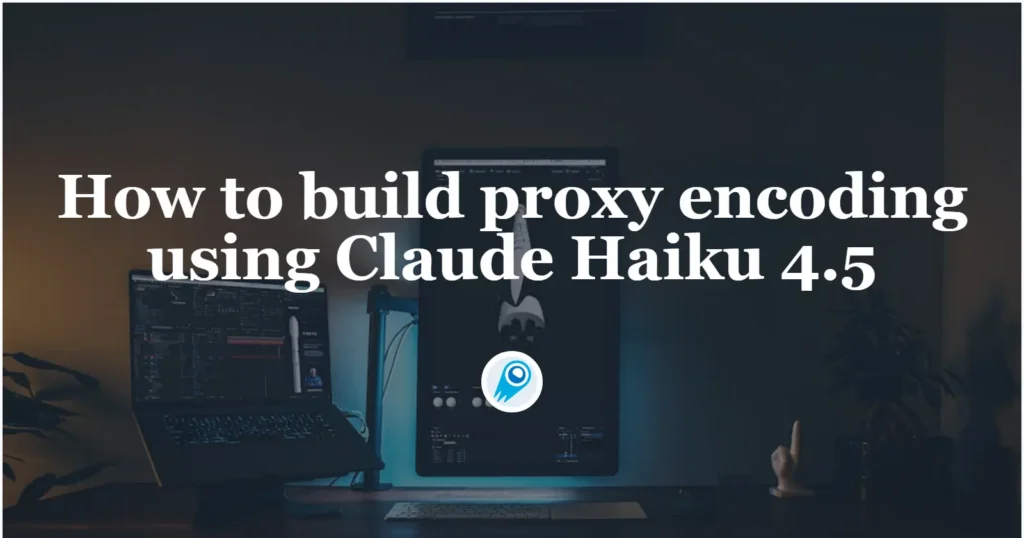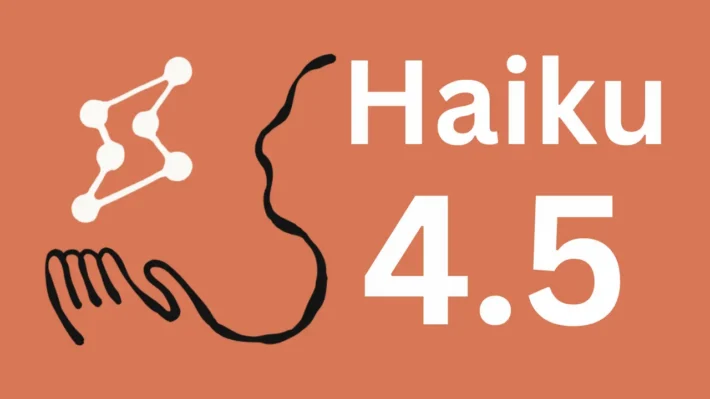How to build proxy encoding using Claude Haiku 4.5

Claude Haiku 4.5 landed as a deliberate play in the “fast, cheap, still very smart” lane: Anthropic positioned it to give Sonnet-level coding and agentic performance at substantially lower cost and with faster latency, making it an attractive choice for subagents and high-throughput tasks. This makes Claude Haiku 4.5 ideal when you want a model to act as a proxy encoder — i.e., convert user text into compact, machine-friendly representations (structured JSON, short semantic codes, intent vectors, labels) that downstream components (retrievers, tool runners, vector stores) can operate on quickly and cheaply.
How to build proxy encoding using Claude Haiku 4.5?
Proxy encoding = convert freeform language → compact structured representation suitable for machines. Examples: a JSON action schema ({"intent":"create_issue","priority":"high","tags":["bug","backend"]}), a canonical short description for retrieval, or an ADT (action descriptor token) that downstream services can parse. Doing this with a lightweight LLM rather than a heavyweight planner can dramatically speed orchestration and lower costs.
A proxy encoding is a lightweight intermediate representation of input data that you produce cheaply and deterministically to feed downstream systems (search, retrieval, routing, or heavier reasoning models). With Claude Haiku 4.5 — a newly announced, small, latency-and-cost-optimised Claude family model — you can implement proxy encoders in two realistic ways:
- Structured text encodings via deterministic prompts — ask Haiku 4.5 to emit a compact, fixed-format JSON or token string that captures salient attributes, categories, and short semantic summaries for downstream use. This is useful when you want human-readable, debuggable encodings and deterministic behavior at low cost.
- Vector embeddings (hybrid) — use a dedicated embeddings endpoint (or an embeddings model) for numeric vectors and use Claude Haiku 4.5 as the orchestration/routing agent that decides how and when to call the embeddings model, or to chunk and pre-process text for the embeddings call.
Both approaches trade different mixes of interpretability, cost, and speed; Claude Haiku 4.5 is explicitly designed to be a very fast, cost-efficient model for coding and agentic use cases, making low-latency proxy encoding patterns practical in production.
Why use Claude Haiku 4.5 as your proxy encoder?
Anthropic introduced Haiku 4.5 as a small, fast, and cost-efficient Claude 4.5 variant that preserves strong coding/computer-use ability while operating at much lower latency and cost than frontier models. That makes it ideal for high-throughput, low-latency roles such as:
- Edge preprocessing and normalization: clean user prompts, extract structured fields, perform intent classification.
- Subagent execution: run many workers in parallel to complete small tasks (e.g., search summarization, snippet generation, test scaffolding).
- Routing / proxying: decide which inputs require Sonnet (frontier) attention vs. Claude Haiku handling entirely.
Anthropic’s announcement emphasizes Claude Haiku 4.5’s speed and cost advantages and positions it for subagent orchestration and real-time tasks.
Key operational reasons:
- Cost & speed: Anthropic designed Haiku 4.5 to keep near-Sonnet coding and agent capabilities while being faster and much cheaper per call — crucial for high-fan-out scenarios (many subagents each requiring frequent encoding calls).
- Agentic improvements: Claude Haiku 4.5 shows concrete gains in “agentic coding” — the ability to reliably output structured action plans and to be used as a subagent in orchestration patterns. Anthropic’s system card highlights gains in agentic tasks and computer use, which is what you want in a proxy encoder: consistent, parsable outputs.Use Haiku to produce validated JSON encodings or short canonical summaries that downstream components can parse without extra ML steps.
- Ecosystem availability: Claude Haiku 4.5 is available across API surface(Anthropic and CometAPI) and in cloud integrations (e.g., Amazon Bedrock, Vertex AI), making deployment flexible for enterprises.
Practical approaches to “proxy encoding” with Claude Haiku 4.5
Below are two safe and pragmatic approaches: a structured proxy encoding using Haiku 4.5 prompt engineering, and a hybrid embedding approach where Haiku orchestrates embeddings calls.
A — Structured proxy encodings via deterministic prompting
Goal: produce a compact, reproducible, human-readable encoding (e.g., a 6-field JSON) that captures intent, entities, short summary, category tags, and confidence flags.
When to use: when interpretability, debugging, and tiny output size matter more than numeric vector similarity.
How it works:
- Send each text chunk to Claude Haiku 4.5 with a strict system prompt that defines the exact JSON schema you want.
- Set temperature to 0 (or low) and constrain token length.
- The model returns a JSON string that your microservice parses and normalizes.
Advantages: Easy to inspect, stable, low cost, fast.
Tradeoffs: Not directly usable as numeric vectors for nearest-neighbor search; may require hashing/encoding to compare.
B — Hybrid embedding pipeline (Haiku as preprocessor / router)
Goal: get numeric vectors for semantic search while using Haiku to pre-process, chunk, and flag what should be embedded.
How it works:
- Haiku receives raw input and produces chunk boundaries, canonicalized text, and metadata fields.
- For each chunk Haiku marks as “embed = true”, call a dedicated embeddings API (could be Anthropic’s embeddings or a vector model).
- Store embeddings + Haiku’s metadata in your vector DB.
Advantages: Combines speed/cost efficiency of Claude Haiku for deterministic chores with high-quality embeddings where necessary; orchestrator can batch many embeddings calls to control spend. Embeddings APIs are typically separate from Haiku; design your orchestrator to pick the right model for embeddings.
Minimal working example (Python)
Below is a concise, practical Python example showing both patterns:
- Structured proxy encoding using
claude-haiku-4-5via Anthropic’s Python SDK. - Hybrid variant showing how you might call a hypothetical embeddings endpoint after Claude Haiku decides which chunks to embed.
NOTE: replace
ANTHROPIC_API_KEYand embedding model IDs with values from your account and provider. The example follows the Anthropic SDK call patternclient.messages.create(...)documented in the official SDK and examples.
# proxy_encoder.py
import os
import json
from typing import List, Dict
from anthropic import Anthropic # pip install anthropic
ANTHROPIC_API_KEY = os.environ.get("ANTHROPIC_API_KEY")
client = Anthropic(api_key=ANTHROPIC_API_KEY)
HAIKU_MODEL = "claude-haiku-4-5" # official model id — verify in your console
SYSTEM_PROMPT = """You are a strict encoder agent. For each input text, output EXACTLY one JSON object
with the schema:
{
"id": "<document id>",
"summary": "<one-sentence summary, <= 20 words>",
"entities": ["<entity1>", "<entity2>", ...],
"categories": ["<tag1>", "..."],
"needs_escalation": true|false,
"notes": "<optional short note>"
}
Return ONLY the JSON object (no explanation). Use truthful concise values. If unknown, use empty strings or empty lists.
"""
def structured_encode(doc_id: str, text: str) -> Dict:
prompt = SYSTEM_PROMPT + "\n\nInputText:\n\"\"\"\n" + text + "\n\"\"\"\n\nRespond with JSON for id: " + doc_id
resp = client.messages.create(
model=HAIKU_MODEL,
messages=[{"role": "system", "content": SYSTEM_PROMPT},
{"role": "user", "content": "Encode document id=" + doc_id + "\n\n" + text}],
max_tokens=300,
temperature=0.0 # deterministic outputs
)
# the SDK returns a field like resp["content"] (consult your SDK version)
raw = resp.get("content") or resp.get("message") or resp.get("completion") or ""
# try to find JSON in response (robust parsing)
try:
return json.loads(raw.strip())
except Exception:
# simple recovery: extract first { ... } block
import re
m = re.search(r"\{.*\}", raw, flags=re.DOTALL)
if m:
return json.loads(m.group(0))
raise
# Example: hybrid pipeline that optionally calls an embeddings service
def process_and_maybe_embed(doc_id: str, text: str, embed_callback):
encoding = structured_encode(doc_id, text)
print("Haiku encoding:", encoding)
if encoding.get("needs_escalation"):
# escalate logic - send to a high-quality reasoning model or human
print("Escalation requested for", doc_id)
return {"encoding": encoding, "embedded": False}
# Decide whether to embed (simple rule)
if "important" in encoding.get("categories", []):
# prepare canonical text (could be a field from encoding)
canonical = encoding.get("summary", "") + "\n\n" + text[:2000]
# call the embedding callback (user provides function to call embeddings model)
vector = embed_callback(canonical)
# store vector and metadata in DB...
return {"encoding": encoding, "embedded": True, "vector_length": len(vector)}
return {"encoding": encoding, "embedded": False}
# Example placeholder embedding callback (replace with your provider)
def dummy_embed_callback(text: str):
# Replace with: call your embeddings API and return list[float]
# Eg: client.embeddings.create(...), or call to other provider
import hashlib, struct
h = hashlib.sha256(text.encode("utf-8")).digest()
# turn into pseudo-float vector for demo — DO NOT use in production
vec = [float(b)/255.0 for b in h[:128]]
return vec
if __name__ == "__main__":
doc = "Acme Corp acquired Cyclone AB for $300M. The deal expands..."
out = process_and_maybe_embed("doc-001", doc, dummy_embed_callback)
print(out)
Notes and production considerations
- Use
temperature=0.0to force deterministic, structured outputs. - Validate JSON schema aggressively; treat model outputs as untrusted until parsed and validated.
- Use prompt caching and deduplication (common chunks) to reduce cost. Anthropic documentation recommends prompt caching for cost reduction.
- For embeddings, use a dedicated embedding model (Anthropic’s or another provider) or vectorization service; Haiku is not primarily an embeddings endpoint — use a dedicated numeric embeddings API when you need similarity search.
When to not use Haiku for encoding
If you need highest-quality embeddings for semantic similarity at scale, use a production embedding model. Haiku is great as a cheap preprocessor and for structured encoding, but numeric vector quality is typically best achieved by specialized embedding endpoints.
How to Access Claude Haiku 4.5 API
CometAPI is a unified API platform that aggregates over 500 AI models from leading providers—such as OpenAI’s GPT series, Google’s Gemini, Anthropic’s Claude, Midjourney, Suno, and more—into a single, developer-friendly interface. By offering consistent authentication, request formatting, and response handling, CometAPI dramatically simplifies the integration of AI capabilities into your applications. Whether you’re building chatbots, image generators, music composers, or data‐driven analytics pipelines, CometAPI lets you iterate faster, control costs, and remain vendor-agnostic—all while tapping into the latest breakthroughs across the AI ecosystem.
Developers can access Claude Haiku 4.5 API through CometAPI, the latest model version is always updated with the official website. To begin, explore the model’s capabilities in the Playground and consult the API guide for detailed instructions. Before accessing, please make sure you have logged in to CometAPI and obtained the API key. CometAPI offer a price far lower than the official price to help you integrate.
Ready to Go?→ Sign up for CometAPI today !
If you want to know more tips, guides and news on AI follow us on VK, X and Discord!
Conclusion
Claude Haiku 4.5 provides a pragmatic, low-cost foundation for building proxy encoding services — especially as a subagent in multi-agent systems where speed, determinism, and cost matter. Use Haiku to produce structured, auditable encodings and to orchestrate what should be embedded or escalated to a stronger model. Combine Haiku’s low latency with an orchestrator (or a higher-capability Sonnet model) to implement robust map-reduce, escalation, and parallel worker patterns described above. For production, follow defensive programming practices: schema validation, prompt caching, rate control, and an explicit escalation path.



